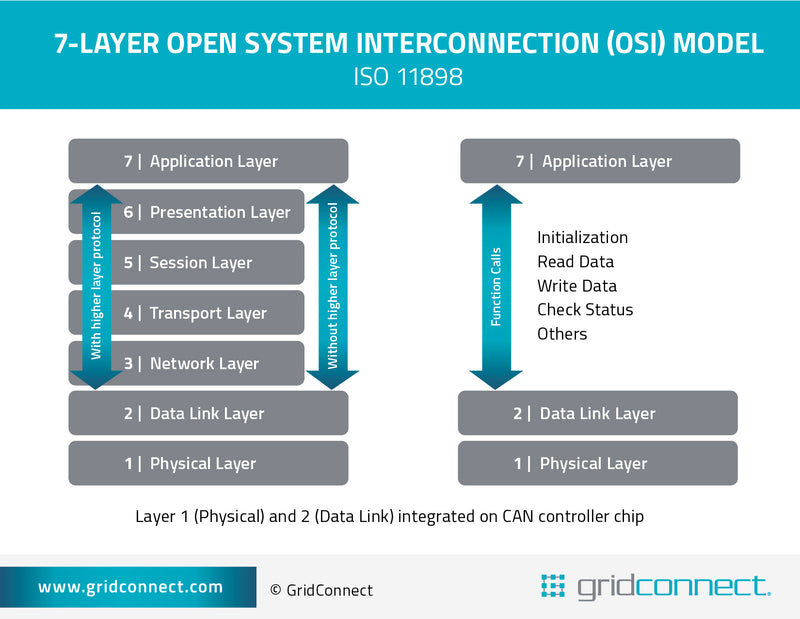CAN is the leading fieldbus communication solution in the automobile industry, yet its reach now extends to other products and industries, including robotics, medical and laboratory equipment, gaming machines, aerospace systems, and more.
For low-cost, lightweight, flexible network communications, CAN is an excellent option. Here’s what you need to know to determine if CAN is a good fit for your automation process or product development needs.
Basic description of CAN protocol
CAN is an acronym for Controller Area Network, a messaging protocol that allows different components of a system to talk to one another. It was developed in 1985 and established as an international standard—ISO 11898—in 1993.
- Before CAN buses, components in a system communicated via transmitters and receivers. Unfortunately, this only allowed for one message to be sent at a time.
- A CAN bus is a two-wire, half duplex, high-speed network system that can create a network of devices in a vehicle or machine. Devices interconnected via the CAN bus can communicate with each other without a host computer.
- If multiple devices transmit simultaneously, the highest priority message gets transmitted first, resulting in non-interrupted transmission and allowing networks to meet deterministic timing constraints.
You can now find “classic” CAN as well as CAN FD, for Flexible Data, developed in 2011. CAN FD provides higher bandwidth of data by allowing dynamic switching to different data-rates and transmission of larger message sizes.
How data is sent and received on a CAN bus
In order to send and receive messages, each device or node in the CAN bus network needs a CPU, a CAN controller, and a CAN transceiver. It is also helpful to have some I/O capability to allow the device to actuate devices or sense events or the environment.
Click here to view the PCAN-MicroMod FD - I/O OEM Module from PEAK System, a leader in CAN components, which can be easily integrated into an application. This compact device integrates I/O functionality into CAN and CAN FD networks allowing for customized OEM designs.
In automobiles, which now rely heavily on CAN technology, you will usually find three different CAN buses, although there could be more. The three are for the body of the car, the powertrain, and the information and entertainment system for radio, GPS, etc.
More on CAN data transmission
|
CAN is a multi-master serial bus standard for connecting Electronic Control Units or ECUs, known as nodes. |
|
 |
|
|
Two or more nodes are required on the CAN network to communicate. |
All nodes are connected through a two-wire twisted pair cable with a 120 Ω (nominal) characteristic impedance. |
The CAN bus is standardized to allow multiple vendors to interconnect devices. The CAN physical layer defines things like cable types, electrical signal levels, node requirements, cable impedance etc.
- Baud rate: CAN nodes must be connected via a two-wire bus with baud rates up to 1 Mbit/s (Classical CAN) or 5 Mbit/s (CAN FD).
- Cable length: Maximum CAN cable lengths should be between 500 meters (125 kbit/s) and 40 meters (1 Mbit/s).
- Termination: The CAN bus must be properly terminated using a 120 Ohms CAN bus termination resistor at each end of the bus
Key benefits of CAN
Along with being well-established (in-market since the late 1980s, early 90s) and standardized (ISO 11898), CAN offers a relatively quick on-ramp to creating and maintaining networks that are both simple and robust, with several valuable advantages.
|
Low Cost |
Flexible |
Accurate |
|
Reduced wiring, weight, and errors are three features that make CAN an economical option for network development and maintenance. |
Since every network device has a CAN controller chip, modifications can be made faster and easier, with minimal overall impact. CAN also provides flexible data transmission. |
CAN incorporates five error detection modes to identify and reject erroneous messages and enable re- transmission of lost messages, as well as identifying and disconnecting nodes that consistently transmit errors. |
|
Simple |
Centralized |
Efficient |
|
ECUs communicate via a single CAN system instead of multiple direct, complex analog signal lines. |
The CAN bus provides 'one point-of-entry' to communicate with all network ECUs, enabling central diagnostics, data logging and configuration. |
CAN frames are prioritized by ID so that top priority data gets immediate bus access, without causing interruption of other frames. |
CAN technical advantages include:
- Short, high message frequency, more than 10,000/s.
- High bandwidth utilization.
- Reasonable transmission speeds.
- Support for higher-layer protocols like CANopen (standardized protocol for devices and applications from different manufacturers) and J1939 (standard for heavy-duty vehicles).
CAN networking disadvantages
Like most technologies, CAN does have its weaknesses, which include:
- Because of electrical loading, the number of connected devices is limited to a maximum of 64 nodes.
- Cable length is limited to 40 meters (a touch over 131 feet) in length, which is not a problem for most use cases, but could limit some applications.
- According to the standard, the maximum speed is 1 Mbit/second, although this limitation has been solved in CAN FD, which offers 5 Mbit/s.
- CAN can produce excessive electric noise.
- While CAN reduces some costs, software development and maintenance expenses can be high.
Grid Connect engineers are happy to discuss these characteristics in regard to your needs and to offer ideas for workarounds or alternative options.
Application examples of CAN networking
- Majority of applications as CAN was developed for automobiles
- In use by most domestic and international car manufacturers
- Automotive Aftermarket
- Fleet and vehicle tracking
- Vehicle security and remote start applications
- Elevators and escalators
- Access control, secure doors
- Light control
- Industrial Automation
- Robotics
- Predictive maintenance
- Medical Equipment
- X-ray generators and patient tables
- Dose measurement systems
- CT scanners
- Entertainment
- Gaming machines
- Motion picture camera and lighting systems
The Future of the CAN Bus Protocol
You may find information on the internet saying CAN is or will be obsolete, replaced by faster, more powerful Ethernet or 2 wire Ethernet, which may be the future.
Ethernet TCP/IP has its strengths, yet it still can’t deliver some key benefits that CAN bus networks deliver:
- Low resource requirements.
- Low-cost implementation.
- Reliable error checking and recovery capabilities.
We believe the CAN bus protocol will continue to maintain a market leadership position for networking applications that require frequent, simple communications among connected devices.
If you believe or still wonder whether CAN is the right fit for your needs, don’t hesitate to contact us to discuss your requirements and objectives for your use case.
GridConnect has years of CAN experience, and we represent some of the leading manufacturers of CAN hardware components, like PEAK System and CSS Electronics. We can help you implement a CAN bus system that will enhance efficiency, streamline operations, reduce expenses, improve safety, and more.
Meanwhile, if you want to learn more about CAN, go to this knowledge page on the CIA website. (FYI, this won’t take you to the US spy organization, but to the international “CAN In Automation” association website!)








